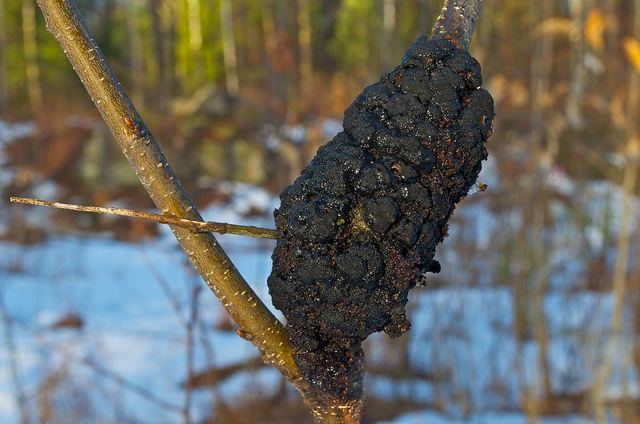This is the second part of a series on spring tree diseases. This article examines black knot, and brittle cinder.
Introduction
In spring, as the growing season commences, trees become vulnerable to infection from a bevy of diseases. While some of these diseases are relatively benign, many of them can cripple their hosts. The following describes some of the most common diseases to afflict plants in spring, and how they impact their hosts.
Black Knot (Apiosporina morbosa)
Black knot is a fungal disease that infects over 25 species of Prunus. It is caused by the fungus Apiosporina morbosa. Outbreaks of black knot may occur in landscape and forested settings. The knots that form on infected plants can cause extensive defoliation, and foliar dieback. Tree mortality is common in young or highly susceptible species of Prunus.
Hosts
Black knot primarily affects plum and cherry trees. Over 25 species of Prunus are susceptible to infection, including American, Canadian, European, Japanese, and purple-leaf plum, as well as chokeberry, and European bird cherry. Infections also occur on amur, apricot, chokecherry, and flowering almond, as well as on several other varieties of cherry, including Nanking, pin, Sargent, sour, and western sand cherry.
Symptoms of Infection
Knobby, irregular black swellings will grow parallel along the length of infected stems and branches. During the first year, the knots may be difficult to discern. As the galls increase in size, they become more conspicuous. They are most apparent in winter, when the hosts have shed their leaves. Once the galls mature, they harden and turn black. Infected branches may become malformed, assuming a bent or distorted appearance. Girdled branches are often bereft of healthy growth. Leaves that do emerge tend to be stunted, and will generally wilt before expiring in early summer. The canopies of infected plants may become laden with up to several hundred knots. The knots may ooze a sticky liquid, when can be observed streaming down the main trunk of the plant. Older knots may brighten in color, turning white or pink. This discoloration is caused by another fungal parasite, Trichothecium roseum.
Treatment
- Landscape and forested sites that contain an abundance of Prunus species should be monitored consistently for infection symptoms.
- Prune and dispose of any knots that are present to reduce the incidence of infection. In late winter, remove all branches with swellings, cracks in the bark, or black knots. Diseased plant material should be disposed of thereafter.
- Knots that are cracked or oozing, especially those located on the main trunk of a plant, should be inspected by a certified arborist. Knots that have grown on or into the main trunk can disrupt the structural integrity of the plant, rendering it prone to failure.
- When planting, select trees that exhibit an increased resistance to black knot.
- Fungicides may be utilized to protect young or highly susceptible plants from infection. Initial applications should be performed in early spring, as bud expansion begins. Repeat applications at 7 to 14 day intervals until the shoots mature.
Brittle Cinder (Kretzchmaria deusta)
Kretzchmaria deusta, also referred to as brittle cinder, and previously known by the scientific name Ustulina vulgaris, is a fungus and plant pathogen that infects a wide range of broadleaved trees. Once the fungus has infected a plant, it consumes the cellulose and lignin. This promotes the development of a soft rot within the infected plant.
- deusta is an aggressive fungus. Infections often progress rapidly. On severely infected plants, the fungus may penetrate the trunk and roots, causing them to decay. This renders the plant more prone to failure. K. deusta is a facultative parasite; it can thrive on healthy trees, and decaying stumps. After a plant has succumbed to infection, the fungus will continue to decay the diseased wood.
Hosts
- deusta commonly infects beech, lime, maple, and oak. It also infects hackberry, hornbeam, horse chestnut, and sycamore, albeit with less frequency.
Symptoms of Infection
Infected plants will often exhibit few external symptoms. They do not bulge, rupture, or crack. Instead, they develop hard, inflexible wood. As the infection deepens, black lines can be observed beneath the bark on the damaged wood. The fruiting bodies are most apparent when they are immature. Once they have darkened, they become more difficult to discern. When an infection has advanced into the trunk or root system of a plant, it may cause the plant to lean or tip to one side.
Treatment
- In spring, inspect plants that are vulnerable to infection. During this period, the fruiting bodies may be easily detected.
- Severely infected plants are structurally compromised. Given the nature of the fungus, and how rapidly it can spread, infected plants, particularly those located near buildings or roads, should be felled.
- Safely dispose of any debris shed by infected plants. Avoid using it as mulch or compost.
Photo courtesy of Distant Hill Gardens CC-by-2.0


